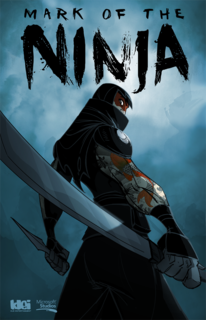INTRO:
There have been quite a number of stealth-oriented games, ever since Thief and Splinter Cell popularized the idea of taking on, or working around, overwhelming hostile opposition with guile and cunning. However, the bulk of these involve three-dimensional environments.
Klei Entertainment, not a stranger to games which involve levels which are two-dimensional planes, has decided that it should do something different yet something it is familiar with. It makes a stealth game, but reduces the gameplay of that genre to 2D planes.
The skeptical/cynical would think that this reduction is just a dumbing-down, nowhere near the sophistication seen in “true” stealth games. They are indeed quite right. However, that is not saying that the game is incompetently done – it is far from that.

HUMBLE BUNDLE PACKAGE:
This review is made with a package from a Humble Bundle deal. It has no DRM and does not need to be “installed” after it has been extracted from its compressed archive. Instead, it can be played right away; any progress record and settings options are saved as files within the same directory. This is very convenient.
The same cannot be said about “true” stealth games though. For example, Ubisoft, the owner of the Splinter Cell series, is loath to make any game without any DRM, and if it had, these are far and few in between.
(Of course, that was just a short off-topic rant about big-name game-makers “ruining” the stealth genre with their business decisions.)
NINJAS:
As the name of the game already suggests, it involves ninjas. According to (near-mythical) historical accounts of ninja, they are supposed to be stealthy agents of murder, theft and sabotage. Klei’s ninjas will not go too far from such a representation.
One could argue that Klei is not being imaginative with its choices of player characters. After all, ninjas had been the protagonists of many video games before Klei’s.
Yet, it has to be said here that there are not many games – even Japanese ones – which have an emphasis on the stealthy aspect of a ninja. For example, high-profile franchises like Ninja Gaiden emphasize their mythical and superhuman aspects instead, mainly for the pizzazz of ninpou and such other far-fetched things.
That is not to say Klei would not resort to anything outrageous though. However, Klei’s game does happen to be more about ninja being sneaky instead of being able to breath fire or cut through tanks, among other examples of absurdities.

PREMISE:
The game does not start with a boringly length exposition on what is happening. Instead, it throws the player into a worrisome situation right away (albeit after recycling certain animated scenes which have been seen in promotional material for the game already).
The protagonist, obviously a male ninja, wakes up in a section of his clan’s dojo. He is told by a female associate that he had been injured in a recent mission to steal things from a corporation, and that those whom he stole from has tracked him down to their home.
For whatever reason, the clan’s master has foreseen this disaster coming, and had already chosen the protagonist to be the clan’s one-shot champion. He is to receive tattoos which will grant him superhuman powers, in return for eventual loss of sanity. With these, he is expected to strike at the corporation and destroy it in order to preserve the safety of his clan.
Experienced players will know that there is more than meets the eye. There are suspicious circumstances, such as how the relatively clumsy corporation mercenaries could manage to surprise a clan of ninja and why an associate follows the protagonist around when ninja is anecdotally mentioned to work alone.
Of course, to describe more here would be to include spoilers, but it should suffice to say for now that the game will come up with plenty of excuses for the player character to infiltrate yet another heavily guarded location.
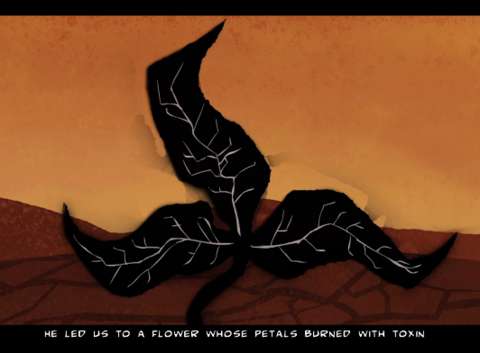
MOVEMENT:
The first lessons which are taught to the player is movement. Being a ninja, the protagonist is capable of fast, tireless motion, or sneakily efficient creeping. He is also capable of climbing and clinging onto almost any surface; these surfaces have white trims which indicate that they can be climbed onto.
The observant player will also notice that there are context-sensitive prompts which appear at the top right corner of the screen. These include movement options too, such as vaulting onto an adjacent surface if possible.
The player character moves at a slow but silent pace by default, but the player can have him running if this is more prudent. Of course, this makes more noise; there will be more elaboration on the element of noise shortly. Nonetheless, this drawback can still be used to the player’s advantage.
LIGHT & NOISE:
Not long afterwards, the player is instructed on the basics of staying hidden and undetected. There are two factors which determine the player’s continued success at doing so: light and noise.
According to this game’s interpretation of anecdotes and apocryphal documents about ninja, a ninja is expected to stay to the shadows, so getting illuminated by any light source is undesirable. Gameplay-wise, being illuminated makes the ninja a lot easier to spot, even from a long distance.
Being a video game ninja, the protagonist does not need illumination to see anything; the player will always be able to see the outlines of objects and persons in the dark, if there are no obstacles which obscure enemies from the player character’s “view”, with respect to his relative position.
As for anyone else who is not a ninja, he generally can only see a few feet ahead if he is not actively using his portable light source or some other means of seeing in the dark.
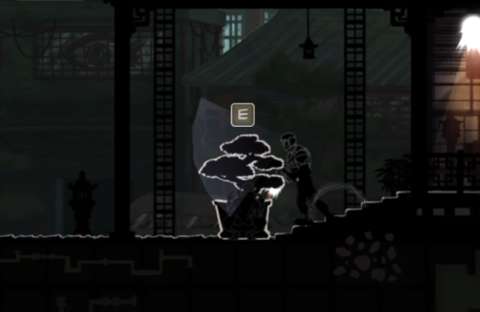
The player can knock out any light source which he/she sees to plunge rooms into darkness. Of course, this makes considerable noise.
Speaking of which, noise is another way to tip off the player character’s presence with. When an occurrence with significant noise occurs, the player can see a light blue shockwave emanating from the location of that occurrence. If this shockwave reaches any enemy, the enemy has been alerted to that noise and will go over to investigate.
Obviously, the player might not want to have the player character linger in that location when this happens. On the other hand, the player can use noises to distract enemies, thus making them move away from their posts or simply looking the other way as the player character creeps up to them.
What makes noise and what does not is not immediately clear, but the reasons for this should be understandable. For example, if the player character drops from a short height, the fall does not make significant noise. If he falls from a great height (he cannot die from such falls), he makes noise instead.
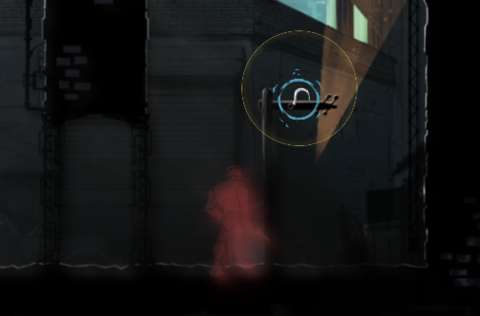
NINJA TOOLS – IN GENERAL:
Mark of the Ninja will not move away from the trope of giving the player character tools when he needs them. The protagonist, who is presumably already a well-trained ninja, is given access to ninja tools (presumably planted by his associates somewhere in the levels). This can seem a bit contrived, but there can always be the argument that his clan does not equip its members so readily all the time.
By default, the player character can only carry two types of tools at a time; these tools are further categorized into “distraction” items and “attack” items, and the player character can usually only carry one type from each category. There are options to get different limitations of course; these will be described later.
GRAPPLING HOOK:
The first ninja tool which the player would get is a grappling hook. This will be needed to reach perches and ledges.
However, Mark of the Ninja does throw some physics out of the window. After grappling onto a perch or ledge, the protagonist zips straight onto it without any discernible swing momentum. As unbelievable as this is, it is nevertheless slick and more importantly, convenient.
If there happens to be multiple grappling points in sight, the player can use the mouse to select any one of these to grapple onto. This is much more difficult to perform mid-jump though.
GARBS:
The player starts with the garb which the protagonist’s clan uses. However, after the player has achieved certain conditions, more ninja garbs are made available. These are not just there for looks; they do happen to grant special bonuses, but also impose certain drawbacks. For example, the “Hunter” garb removes the reflex mini-game for stealth kills (which will be described later), but disallows the player from carrying distraction items.
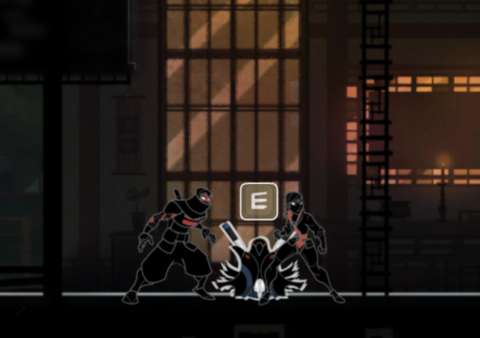
SWORD:
Killing enemies is a necessity in the gameplay, so the player character is given a sword for when an enemy has to be silenced with application of painful death. The mechanics of killing enemies with the sword will be described later.
For whatever reason though, the ninja can only kill with a sword; there will be no hand-to-hand killing moves, much less neck-snapping. (There are no non-lethal take-downs either.)
The use of the sword strongly suggests blood-letting. However, leaving blood around is not an issue in the gameplay; there will be no bloodstains to worry about or clean after.
KUNAI:
A fictitious popular-culture ninja would not be one without some throwing weapons. For the ninja in Klei’s game, he is armed with kunai, i.e. throwing daggers.
However, the player is quickly disabused of the notion that kunai can be used to kill enemies from afar; most enemies are armored or have some means of rendering them useless. Rather, they are used to knock out lights, hit things to make noise or just to poke at enemies so that they get annoyed and move away from their patrol paths or sentry posts.
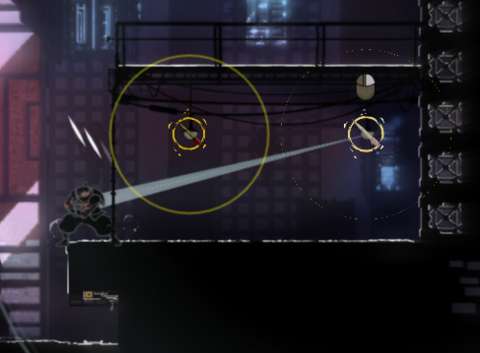
It should be noted here that the player character has an unlimited supply of kunai and the cool-down time for using kunai is so short as to be nearly imperceptible. Therefore, kunai can be used for some cheesy tactics, such as tossing them at somewhere near enemies to alert and lure them to that location.
NOISE-MAKERS:
Noise-makers are practically firecrackers. They are the first ninja tool to have limited supplies, so the player must be careful in how he/she spends them. Re-supplies are generally rare too.
Anyway, noise-makers, as their name already suggests, makes a lot of noise. They are mainly there to allow the player to distract a large number of enemies, luring them away so that the player character can relocate to a more convenient position.
SMOKE BOMBS:
There is an almost clichéd trope about video game ninjas; this trope is about them tossing smoke bombs to create a diversion so that they can escape. It is arguably practical, but smoke bombs would hinder the ninja as much as it hinders enemies.
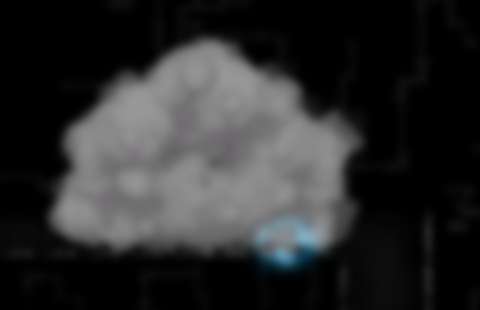
With that said, the player character in this game can toss smoke bombs too. In addition to blocking the vision of enemies which are caught in them, they also foul trip lasers. Smoke bombs also obviously act as temporary obstructions to vision.
SPIKE MINE:
The Spike Mine is the first lethal ninja tool which the player character has. Tossing one down causes a small amount of noise; enemies who noticed it will shoot at it to destroy it and will be permanently alarmed afterwards. (There will be elaboration on the suspicion system later.)
If the spike mine is laid down without any trouble, it becomes ready to slay the first enemy which it comes across.
Spike mines are also an example of killing methods which can terrify enemies who watched colleagues get killed by them; there will be elaboration on the gameplay element of terror later.
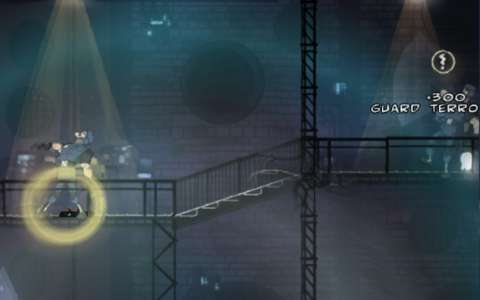
TERROR DARTS:
One of the most hilarious but preciously fewest ninja tools is the terror dart. When this poisoned projectile hits any – any – enemy, that enemy is rendered quite hopelessly useless as a guard.
For most enemies, they are subjected to terror, which will be described later. In most cases, they also start shooting at where the dart came from; new players would learn the hard way to quickly vacate the area after throwing a dart. However, more cunning players would time a dart throw so that the victims end up shooting allies.
Terror darts are also the only weapons capable of ruining the nerves of hardened enemies, which appear much later in the game. The darts’ effectiveness vary though; some scramble in panic, others are frozen in place in fear.
DISTRACTION FLARES:
As their name suggests, these flares are intended to fool enemies away from their positions. They also happen to stun enemies with night-vision capabilities, of which there are two in the game. In fact, the distraction flare is one of a few types of ninja tools which work well against one of these two enemies.
RAVENOUS INSECTS:
Ravenous insects are perhaps the most potentially lucrative tool to use, with regards to racking up scores. This is because of a few reasons: they kill a living target immediately, thus counting as a “tool kill” (which scores more points than even stealth kills); they “hide” the body of the victim, thus granting the points for hiding bodies; finally, they terrorize (most) enemies who watched this happen.
Other than that, ravenous insects are the only means to remove bodies which cannot be chucked somewhere which the game considers as a good hiding spot.
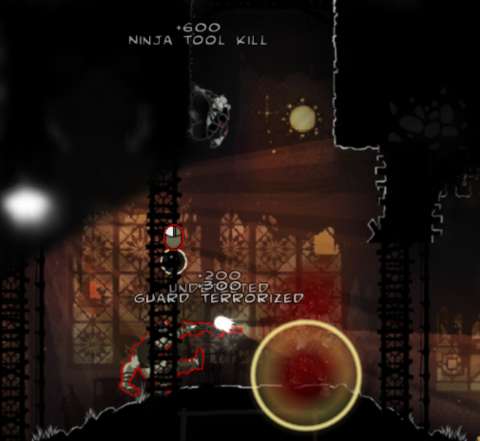
CALTROPS:
Caltrops appear to be little than tools to stun (most) enemies with. Enemies who stepped on caltrops will grimace in pain, staying put where they are for a while. Visual indicators appear over their heads, informing the player that they are vulnerable to stealth kills. In this case, the stealth kills automatically succeed without the player having to perform mini-games.
CARDBOARD BOX:
In what is an obvious homage to the Metal Gear franchise, or a reference to cartoonish sneaky shenanigans in general, there is a cardboard box which the ninja can use. There is an attempt by the writers to rationalize its presence in the game of course.
Anyway, with this “equipped”, the player character pulls a fully-folded cardboard box out of somewhere on his person and use it as a mobile hiding spot. It can be upgraded to allow the player character to perform a stealth kill which then drags the corpse underneath the box, effectively hiding the body as well. Alternatively, the player can recover the box, but the corpse would become exposed.
TOOL UPGRADES:
After obtaining tools, the player gains opportunities to improve them, specifically through the game’s progression system which will be described later.
These improvements can take away the drawbacks of these tools. For example, the Spike Mine’s clunking noise when it lands after being thrown can be reduced drastically with its upgrade. Alternatively, the improvements may expand the capabilities of the tools instead. For example, distraction flares can be remotely detonated after its upgrade is purchased.
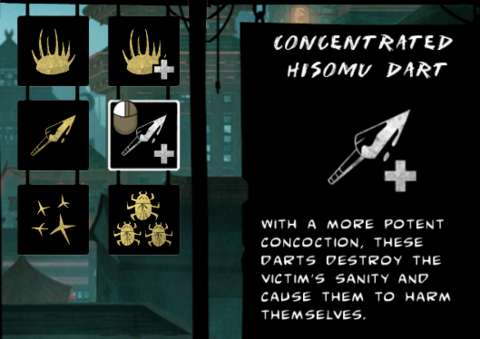
HAND-TO-HAND COMBAT:
The ninja’s sword is apparently only there for stealth kills. For more furious combat, the ninja resorts to flurries of punches, palm-strikes and kicks instead. Enemies who are beaten down by close-combat attacks do not die, but they are rendered vulnerable to killing moves.
It is worth noting here that there are few enemies which make use of close-combat attacks; most enemies prefer to shoot instead. This means that the ninja might have an advantage if he can get close enough to engage enemies; they have very few hard counters to his close-combat attacks.
However, in practice, taking out enemies in such a manner is very risky and a lot more tedious than resorting to stealth kills. This is because most enemies will not stand still and let the ninja beat them down; they will dodge about, attempting to put distance between them and the ninja so that they can shoot their weapons.
CAUSING ACCIDENTS:
Ninja tools, especially the kunai, can be used to cause deadly accidents. For example, hitting a pile of scrap which is on a ledge causes it to fall onto a dumb sentry below it. As another example, a chandelier can be detached with a kunai hit so that it crashes onto the head of a patrolling guard.
There are not a lot of opportunities to cause accidents, but the player is rewarded for pursuing such ways.
FOCUS:
There is a trend – or a trope, if one is cynical – in the stealth game genre nowadays; it is about having a gameplay element which stops or slows in-game time, mainly to give the player the opportunity to make decisions at leisure. Klei’s stealth game follows this trend.
Thanks to his tattoos, the player character can “focus” his concentration. This pauses time so that the player can make decisions on where to throw kunai, firecrackers or any of the other aforementioned ninja tools.
It is not meant for combat purposes, which can be a disappointment if the player is expecting “bullet time” action, or which can be a relief, if the player does not want the game to follow another trope.
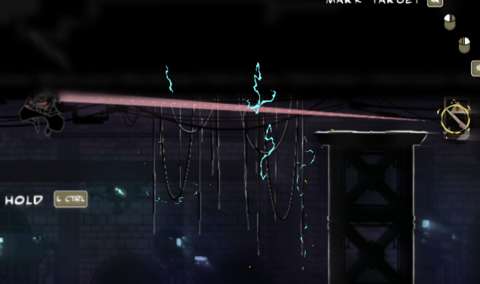
At the very least, there is no “energy meter” of any sort to constrain the use of focus. The player can trigger it at almost any time too.
MARK SENSE:
Slightly more than halfway into a playthrough, the player character gains the ability to detect life and energy through walls and other obstacles in a limited radius. This is timely, because the levels at this stage of the game are more convoluted than the earlier ones and it is easy to miss enemies who might be alerted by loud noises through walls.
STEALTH KILLS – MOUSE-SWIPING:
Killing enemies without them realizing that they are being stalked is the main gameplay element in Mark of the Ninja. For the most part, it is executed quite well: it is easy to perform, but it is not so simple as to make the player complacent.
On the other hand, how the game makes it more than just a simple tap of a button may not go down well with everyone. This is because each and every stealth kill requires the player to perform what is essentially a quick-time event with motion-controlled inputs.
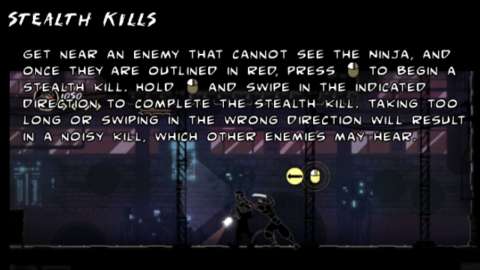
Of course, the apologists for this game can argue that this quick-time event is just a mouse swipe, with a 50-50 chance of it being either swipe to the left or to the right. It is indeed quite simple, especially when compared to the elaborately tedious quick-time events seen in other games such as some of Capcom’s more dubious titles.
Still, it has to be said here that if the developers wanted an extra layer of control input for stealth kills, it should have had more significance than just a reflex test.
STEALTH KILLS – METHODS OF APPROACH:
There are several ways to kill unsuspecting enemies, but all of these ways generally need the achievement of two requirements: the attack came from anywhere but in front of them, and they have yet to confirm the player character’s presence. If they are merely suspicious, they can still be ambushed anyway.
With that said, there are plenty of ways to dispatch unobservant fools in this game. They can be stabbed from behind as usual, or dragged into vents and slain. Later, there are other ways to slay enemies with, such as hanging them from perches or yanking them off ledges. Alternatively, they can be lured into traps.
All of these would be nothing new to veterans of stealth games of course. However, it has to be said here that Klei nailed all of these quite well, considering that Klei has never specialized in any particular kind of gameplay if its portfolio is to be examined.
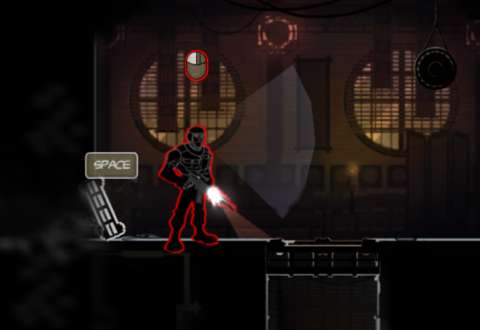
Also, there are mildly amusing phrases which come up after a stealth kill, usually an allegory or metaphor for what has just happened. For example, the stealth kill which is performed by ambushing from a vent grating is allegorized as the natural behavior of the trapdoor spider.
HIDING CORPSES:
Although it has been said earlier that the player does not need to worry about blood from having cut or impaled unsuspecting fools, the player does have to worry about corpses being found. Having enemies see corpses immediately turns them suspicious, and permanently too.
Anyway, the player character can drag corpses around, but not carry them on his shoulders. He also (obviously) cannot jump when he is dragging corpses around. He can throw them, but this is at best only useful for moving them onto lower platforms – or off the boundaries of the level, if there is such a convenience.
Such limitations can be considered a flaw in the gameplay. Being able to shove corpses onto higher or lower platforms through context-sensitive prompts would have been a welcome convenience.
Furthermore, if there is a platform which allows the player to drop down from it or jump onto it, dropping a body here immediately causes it to fall off. Usually, this is desirable, e.g. dropping bodies through floor grates, but sometimes, this results in corpses falling off onto places where other enemies are patrolling.
Dragging corpses up staircases is also a drag – pun intended. The game does not inform the player that if there are two paths to drag a corpse onto, the player must enter movement inputs in the direction of either of these paths.
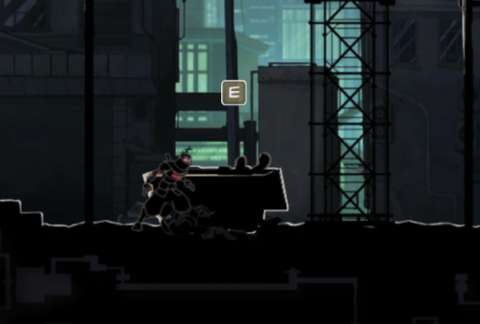
Anyway, once the player has learned to put up with the hassle of moving corpses, he/she has to learn where to stash them in order for the game to consider them “hidden”. Usually, these are believable places, such as within closets, within the vents, or within dumpsters. Alternatively, the player can dispose of them permanently by tossing them off level boundaries.
Successfully “hiding” a body grants the player some points. There will be more elaboration on the score point system later.
HIDING ONESELF:
Among stealth games, there is a trope – or a running gag – that enemies cannot see the player character if he is hidden behind or in something, such as dumpsters, closets and such. Klei’s game does not stay away from this trope.
That is not to say that the game is worse for that though. Hiding behind potted plants and within alcoves, among other things, while careless guards pass by can be entertaining. Doing so also lets the player earn the point bonus for being “undetected” by them.
If there is a problem, it is that the player character will come out of this hiding place to its right by default. There does not appear to be any control input to have him come out of it exactly at its location.
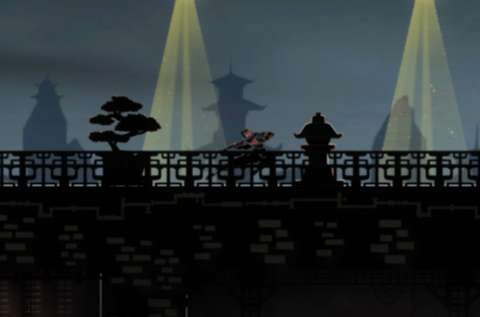
DOORWAYS & VENT GRATES:
Some regions in the levels are sequestered with doorways and vent grates. These stall the movement of both the player character and enemies. More importantly, they block the line of sight of enemies and laser beams too.
Enemies can open doorways. They have the advantage of having very short animations, and it so happens that doors close automatically after them, unlike the player character, who has to close doors after himself. On the other hand, the automatic closure of doors after enemies is actually beneficial to the player.
Most enemies cannot use vent grates though. Therefore, they are quite useful for quick getaways if the player is at risk of being detected.
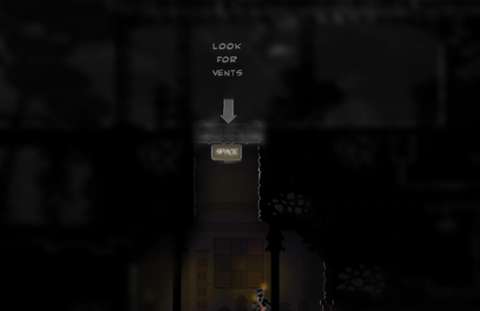
For purposes of reconnaissance, the player character can “look” through doorways and vent grates to perceive what is on the other side. This is quite important; barging through to the other side is a very easy way to be detected.
However, this convenience does come with a risk. When the player character is pressing himself to a grate or door, his awareness of his immediate surroundings diminishes; this is shown through the blurring of the regions behind his sprite. The blurriness also extends to any visual indicators which might come up in this region.
Therefore, it is in the player’s interest to at least clear this region of any threats before peeking through into the next one – or at least just be quick about that.
SWITCHES:
Yet another staple of the stealth game genre are switches which the player has to throw in order to turn something on or off. These can be toggle switches which control objects with binary states, or one-way switches such as fuse-boxes which can be hit to turn pesky security lasers off.
Switches tend to have colour or lighting schemes which make them stand out from the rest of the level.
LASERS:
Where the opposition lacks skill and finesse, they compensate with technology. One example of technology is the laser grids which they use.
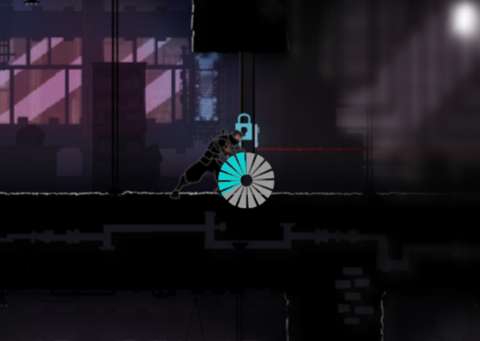
There are two types of lasers: trip lasers and zappy lasers. The former, as their name suggests, are linked to alarms. Crossing them means that the player character has been detected, and the player can expect a lot of guards to be rushing over to the area where he was detected. The trip lasers may also activate automated gun turrets, which are depicted as ominous holes in the wall when they are dormant.
Technically, trip lasers can be used to displace guards, but the score penalty due to detection is a major deterrent. It is also very risky, especially if the trip lasers also happen to activate gun turrets.
The other kind of laser does not need alarms to dispose of the player character; it just zaps the ninja outright. To differentiate it from the slightly less lethal laser, it looks thicker and ominously brighter.
Both types of lasers can be circumvented by dragging the corpse of a uniformed guard through their paths; the proximity of the corpse temporarily shuts them off, but not their motors.
Usually, lasers are connected to fuse-boxes which can be hit to turn them off permanently. At other times, the player must make use of hiding places or vents to evade them.
MOTION SCANNER:
Soon enough, the opposition upgrades to include the use of other forms of security. Motion scanners have considerable arcs of detection, but unlike lasers, they do not have long range. Motion scanners can be tricked by staying still when they pass over the player character.
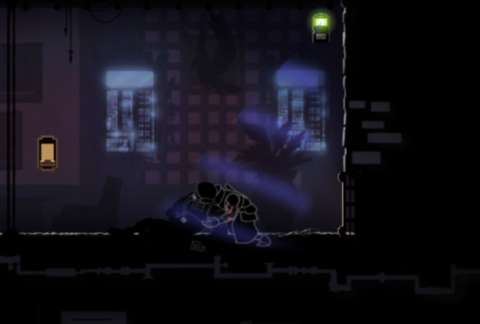
HAZARDS:
There are dangers other than enemies and security apparatus in the levels. These may be exposed electrical cabling and pockets of foul gas, among other examples of severe neglect.
Getting caught in these leads to an embarrassing death. The player character’s lady ally does point out these hazards and the camera is often set at a position at which the player can see them, so it is completely the player’s fault if the player character suffers such a demise.
Observant players may notice that some of these hazards have rules which can be bent. For example, noxious gases only damage the player character when a bar above his head fills up; afterwards, the bar resets. The bar also happens to reset when the player character goes out of the poisonous gas.
It so happens that some of these clouds of gas do not reach particularly high off the floor; the player character can just jump out of them repeatedly to reset them.
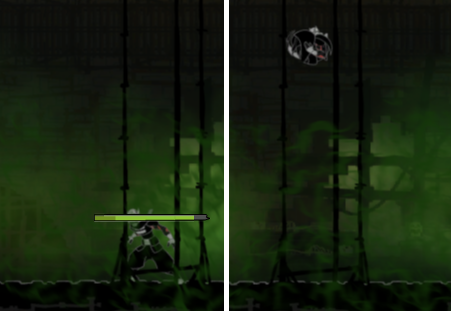
MINES:
Late into the game, contact mines are introduced as traps which the player has to avoid. Most of these mines appear to be hanging off ceilings, waiting for something to jump – or be tossed – into them. They, of course, explode when triggered. The blast range is not extensive, however.
The player can cut their suspending wires off with kunai throws, but this does not destroy them; they just drop down and turn into land-mines. They cannot be destroyed through any means other than tripping them.
As dangerous as they are though, mines are introduced at the same time as enemies which are more dangerous. It so happens that they are unable to perceive these mines, at least when they are on the ground. Therefore, more cunning players would appreciate the presence of these explosive traps, if only to have an option to defeat the aforementioned enemies with.
BLADED TRAPS:
Traps with sharp points or edges appear at about the same time as mines. These immediately kill anyone which are caught in them; even the spear-firing traps are immediately fatal, contrary to the usual video game trope that such traps merely injure the player character.
Unlike mines, enemies do happen to notice these traps – if they have been activated and are obviously functioning. Still, a cunning player can use these traps against them, with some good timing of course.
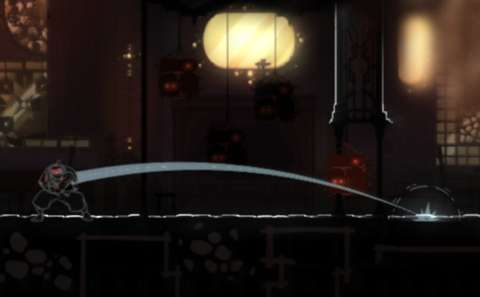
WEATHER:
Thunderstorms and sandstorms occur in the backdrop of certain levels. Far from being cosmetic, they also affect gameplay, at least when the player character is outdoors.
Thunderstorms cause periodic flashes of lightning to make the player character visible when he is outdoors. Obviously, this is not desirable. However, the flashes only grant mere glimpses of the ninja to his enemies; this can be used to the player’s advantage.
Sandstorms block everyone’s sight when they are outside, reducing their range of vision. This is more debilitating to the player character than to enemies, unfortunately; the player’s range of clear vision is reduced by more than half.
If there is anything disappointing about the gameplay element of weather, it is that they do not affect the hearing of enemies. One would think that howling winds would drown out a lot of other noises, but they do not.
HEALTH SYSTEM:
The ninja is not some fragile hero who dies from a single hit. However, like any other protagonists of stealth games, the ninja quickly crumbles under the sustained attention of angry enemies. The player can upgrade him so that he can sustain more hits, but the gist of the game is not getting in trouble with enemies in the first place. Still, the hit points are there to absorb the consequences of carelessness on the player’s part.
MAP SYSTEM:
Levels are generally linear, i.e. the player needs to move from one end of the level to the other end. However, there are several paths which connect these ends together, and each one has some enemies and/or hazards to be neutralized for points.
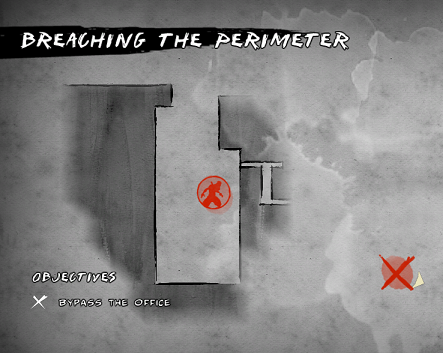
To help the player keep track of which regions of a level have been explored, there is a map system, which shows a map for each level. The map starts out almost empty initially, but becomes filled up as the player explores more of it.
At best, it just shows a very simplified layout of the level. It will not show the locations of treasures and enemies, thus reducing its utility to just a tool to get one’s bearings with. At the very least, it does show the location of the player character and where he needs to go to.
OBJECTIVES:
The objectives which the player needs to follow in order to progress in the story of the game are simple in practice. Most of the time, it is just about getting from point A to point B, sometimes with doing some things at point B. Other objectives include killing this or that person, though this is easier said than done.
Another staple of the stealth game genre which is in Mark of the Ninja is the shadowing mission, as in the player has to follow a mark closely without getting detected and such other limitations.
These objectives would be boringly familiar to a jaded player. However, there are additional goals which make them a bit more palatable, though not necessarily more refreshing to a player who has “seen it all before”.
For example, the player may have to get from point A to point B, but an additional goal requires that the player be completely undetected throughout that easier-said-than-done endeavor. Since the goal is optional, failing it is not a game-over, but achieving it does contribute to a progression system which will be described later.
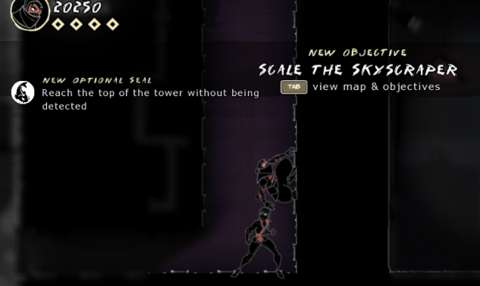
ARTIFACTS & SCROLLS:
For whatever reason, there are animal figurines and scrolls which are strewn throughout a level, sometimes in unlikely places such as within vents; these are obviously the game’s take on the trope of collectibles.
The animal figurines – considered as “artifacts” by the game – are little more than more points to go into the player’s counter for that level. Scrolls are more worthwhile collectibles, however.
The scrolls serve to tell the backstory of the protagonist’s clan, and also an opportunity for Klei’s writers to try their hand at haiku. Perhaps some players will be amused by this, but other people who had been following Klei and who are not already its fans would know that Klei doesn’t exactly have award-winning writers. (However, they are skilled enough to include some decently entertaining plot twists.)
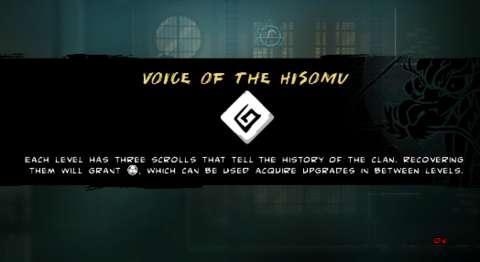
CHALLENGE ROOMS:
As mentioned earlier, the protagonist is doomed to slide into insanity. This is used to rationalize at least one gameplay element: optional puzzles.
These optional puzzles are called “challenge rooms”. The entrances to them appear as mon gate arches, which are usually found in very unlikely places.
After triggering the scripts to start them, the player character is brought to some place which is too surreal to be part of the level proper. This is usually a single room, populated with obstacles which obstruct the way to a collectible, which is generally a scroll. The obstacles here typically require a bit more thinking on the player’s part.
Usually, these puzzles involve the manipulation of obstacles which the player has already encountered prior to attempting them. Some of these puzzles, however, are not. For example, the first challenge room has pressure pads and movable blocks, which have yet to be encountered in the actual levels before this room.
Experienced puzzle-game veterans would have seen such things in other games before, of course. For anyone else, they might need to goof around with the obstacles and get the ninja killed a few times. Fortunately, reloading a challenge room is (usually) a quick matter.

ENEMIES – IN GENERAL:
Staying true to the stealth game genre, most of the enemies which the player would encounter are bored, careless and/or dim-witted. The ones in the first few levels are ‘exemplars’ of these, being mainly there to demonstrate the player character’s sneaky and lethal capabilities.
On the other hand, when they are very much aware of the player character’s presence, they can kill him rather quickly. This is par for the course for a stealth game of course; careless players are punished quickly, and they deserve this.
The later ones are a bit more sophisticated, such as having some means of protecting themselves from being attacked from behind or especially jittery behavior when they become suspicious. Still, as a general rule of thumb, each and every goon has at least one weakness, which can be discovered if the player observes them closely.
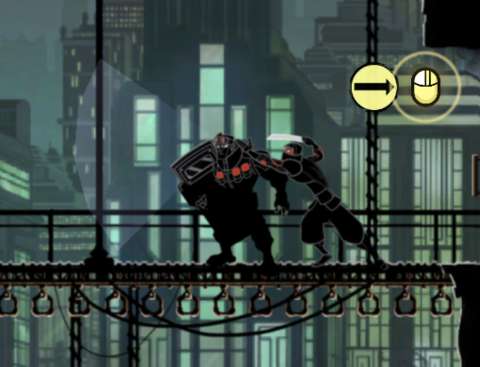
SUSPICION:
Most of the time, enemies are complacent, either standing around in place looking at things or patrolling pre-scripted paths. However, they get suspicious when they see anything out of the norm, such as glimpses of the player character, open doors when they should be closed or light sources being knocked out.
When this happens, they usually move away from their patrol paths or sentry posts to where the disturbance occurred; this is usually depicted with a yellow circle, conveniently.
Alternatively, if two or more enemies have been scripted to work together, one of them might be told by the others to check out a disturbance. However, the new player quickly learns that this cannot be so easily used to pick them off one by one. Rather, if the unlucky person does not return shortly, the others are tipped off that something is not right and their suspicion renews.
Getting enemies suspicious is usually done with the motive of having them turn the other way, thus making them vulnerable to attacks from behind. However, sometimes, it is wiser to distract them so that the player can go around them.
Anyway, enemies will not remain suspicious for long. Eventually, they will convince themselves that nothing is wrong and then return to their posts.
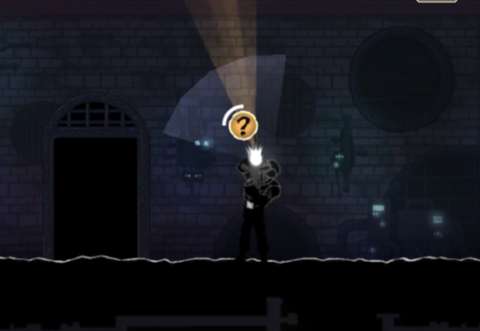
ALERTED ENEMIES:
However, there are conditions where enemies become permanently suspicious. This usually happens when enemies have confirmed the presence of the player character. After this happens, the patrol paths of enemies change and sentries no longer stand sentry. Obviously, this is not desirable.
SLEEPING ENEMIES:
Of course, there are also enemies who are sleeping on the job. These are woken up by loud noises, but otherwise, they are always vulnerable to stealth kills.
TERRIFIED ENEMIES:
Sometimes, enemies can be rendered more than just alarmed or suspicious. If their colleagues are killed in gruesome ways while they are watching, or if the corpses of their colleagues are found in macabre circumstances, they might become terrified. Certain ninja garbs and ninja tools, such as the aforementioned spike mines, guarantee this occurrence.
Terrified enemies become a lot more erratic, jumping in fright at just about any noise which he hears or glimpses of the ninja. Shortly after that, he shoots in the direction of whatever frightened him.
He might even hit his colleagues, which kill the latter outright. In this case, the player obtains more points than killing them first-hand. This makes terrifying enemies a very lucrative tactic.
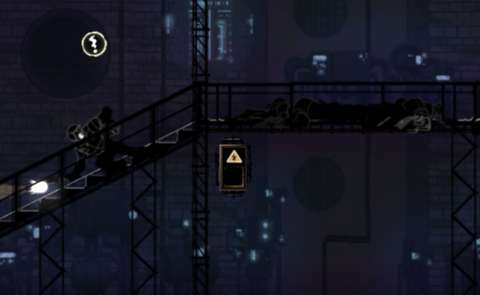
ELITE GUARDS:
There is a trick which a rare few stealth games dare to pull off: enemies which simply render most of the gameplay designs concerning enemies moot. For better or worse, Klei does this trick too.
At the very least, the player is told beforehand that many of the (deadly) shenanigans which the player can perform on other enemies do not work on these particular enemies, the first of which are called “Elite Guards”.
Elite Guards cannot be terrified through any means (other than poisoning them with terror darts) and they are more thorough in searching nooks and crannies.
Indeed, stealth kills cannot even be performed on them, presumably because they are too experienced and tough for them to work; the game even has one of them making a remark that they are trained in martial arts so stealth kills will not work.
In practice though, they do not even use close-combat moves and instead prefer to fire their heavy handguns. If the player can ambush them while they are alone, an unrelenting series of close-combat moves eventually render them vulnerable to killing blows. Conveniently, they also happen to be too proud and confident to yell out, so as long as they are isolated, they are straight-forward (if still a bit risky) to take out without raising a fuss.
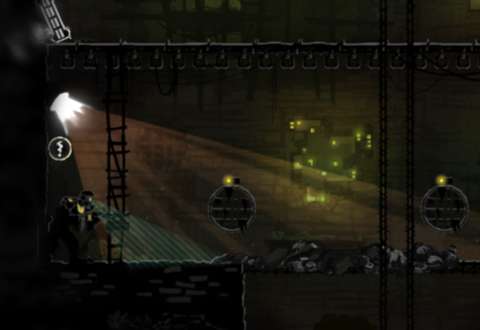
Alternatively, the player can also attempt to place hazards in their path, or lure them into hazards. Most of these hazards will not kill them, but stun them anyway for follow-up killing blows.
ENEMY SENSES:
Generally, all enemies require sight in order to spot threats and respond to them. Yet, as mentioned earlier, most enemies, especially the lowly rifle-armed mercenaries, cannot see further than a few feet in total darkness. Knocking out lights and making places dark almost always works in the player’s favor.
However, most enemies do have some means of seeing in the dark, which they will bring to bear when they become suspicious. For example, the aforementioned mercenaries will shine their path ahead with their flashlights.
Furthermore, there are enemies with additional senses. Some of these are believable, such as dogs, who can smell the player character if he/she comes within their sniffing range (which is depicted with a purple circle). Some later examples include mercenaries with night-vision goggles, which let them see in the dark, and snipers with laser sights (which give their position away, typically enough).
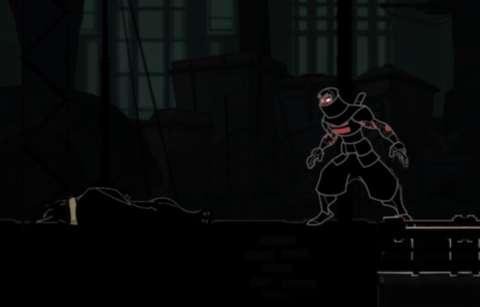
These enemies are more challenging to deal with, but as mentioned earlier, experimentation and observation eventually reveals their weakness. For example, the aforementioned dogs lose their sniffing circle when they are suspicious, presumably because they are keeping their noses close to the ground instead of smelling the ambient air.
STALKERS:
The penultimate enemies in the game are the Stalkers. In addition to having the advantages which Elite Guards have, they also happen to have proximity sensors and night-vision goggles.
More importantly, they are far more agile than other enemies and are capable of climbing walls and going into vents. Obviously, they are much more difficult to slip away from than other enemies.
To top these off, the Stalkers have wrist-mounted laser guns, which inflict a grisly death on the player character with just two hits.
As difficult as they are, they do increase the tension and difficulty of the final few levels, which is appropriate.
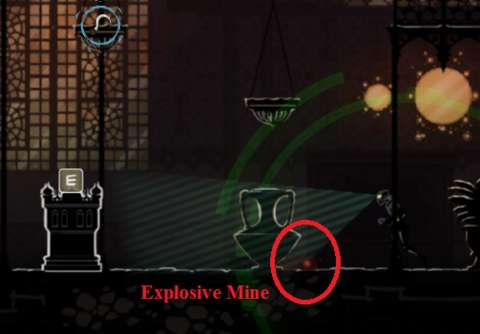
SCORE SYSTEM:
Just about anything the player does against enemies and their assets will grant the player points, usually in the hundreds. These points go into a counter which is created for the current attempt at a level. Gaining points is needed in order to obtain the score-oriented “achievements” of the level.
Actions which successfully neutralize enemies grant more points than most other actions. Each action can only be performed once on any enemy to yield points; the game will keep a tally of what has been done on an enemy.
However, after neutralizing an enemy, that enemy no longer has as many opportunities to grant more points. At best, the player can hide their bodies to gain some more, but that is just about it.
Therefore, it is in the player’s interest to squeeze as many points out of each living enemy as possible if the player wants to rack up a high score.
For example, a guard can be evaded by hiding behind something while he passes by. Then, he can be tricked into moving past a dumpster or closet which contains the corpse of his colleagues. Next, he can be distracted by something. After that, the player can terrify him. Finally, he becomes ripe for slaying.
However, being this meticulously efficient is often not feasible, and generally not worth the trouble if the player only wants to progress in the game. Besides, there are plenty of enemies in any level; killing each of them and hiding their bodies is often enough to achieve the third tier of the score-oriented achievements of that level.

PROGRESSION SYSTEM:
Just about every game has to have some kind of progression system nowadays. Mark of the Ninja is not any different.
As for the variant of the progression system which is used in Mark of the Ninja, it is the kind in which the player must complete levels and accrue “achievement points”.
These achievement points, (stereo-)typically called “honor” in-game, are accrued by racking up high scores, completing optional objectives and collecting scrolls.
Anyway, from the third or so level onwards, there are equipment caches with banners on them. The player can approach these caches to spend “honor” on “upgrades”. Alternatively, the player can also purchase “upgrades” in between levels.
Some of these “upgrades” are combat techniques which the player character should already be trained in, if one is to consider the premise of the game. However, narrative logic takes a backseat to giving the player a tangible albeit contrived sense of accomplishment.
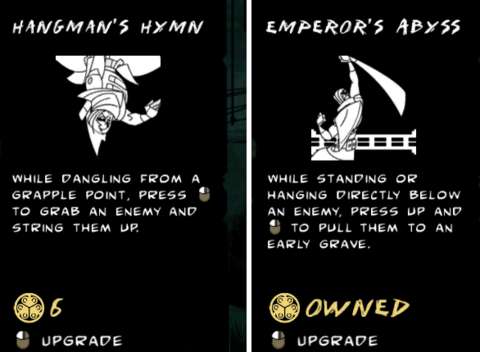
SUPPLY CACHES:
Throughout most levels – usually the second and afterwards – there are locations where the player can find stashes of supplies, presumably placed there by the other members of the protagonist’s clan. The player can use these to alter the protagonist’s load-out, as well as refresh it.
However, using supply caches always requires the player to select garbs and tools again. This can seem a bit tedious. There could have been a feature of convenience to expedite the replenishment of tools at supply caches.
CHECKPOINTS:
Every level is separated into a set of consecutive stretches; the starts and ends of these stretches are depicted by icons of ravens, which are animated when the player character approaches them. These act as checkpoints, auto-saving the player’s progress through a level. They also partially replenish the player character’s supplies.
However, these particular sorts of checkpoints are sparse. Activating them once also renders them inert afterwards.
A few of them appear to be broken, seemingly refusing to trigger when the player character comes close by.
Fortunately, there are other checkpoints which appear throughout a level. There appears to be nothing to denote their presence, but when the player comes close to them, an icon of a stylized dragon appears at the bottom right of the screen. Most of them are merely one-off checkpoints though; it takes considerable experimentation to know which ones are reusable.
The game could have been better if there was a more convenient progress-saving feature – like an actual game-saving facility.
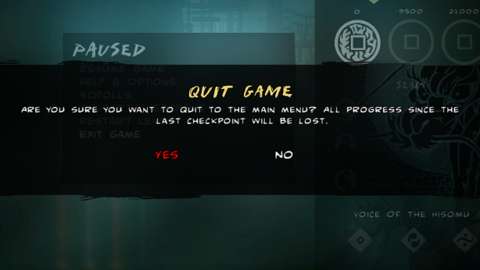
NEW GAME PLUS:
After finishing the first playthrough, the player is given access to the “New Game Plus” mode. This is practically a playthrough which is more difficult in several ways.
Firstly, some conveniences have been removed. For example, in ‘normal’ mode, there are visual indicators for the extent of the noise which the player would make and which enemies would hear them after the player has made decisions in Focus mode; “New Game Plus” removes these.
Secondly, enemies become tougher and their damage output has been increased, but with regards to the gameplay element of stealth kills, they remain just as vulnerable to sneaky tactics. In other words, they remain as dumb as they were.
Most importantly, the player can no longer see so clearly in the regions behind the player character’s sprite (with respect to his facing). This is similar to the blurring effect which is applied on regions which should logically be obscured in the eyes of the player character.
On the other hand, any gear and capabilities which have been unlocked in the first playthrough are retained. The other gameplay elements remain largely unchanged too, so the familiarity helps.
Unfortunately, there are few reasons to play “New Game Plus” other than to experience the additional but limited challenge. There is no additional game content to be had, and neither are there any “secret” endings to reward the player with.
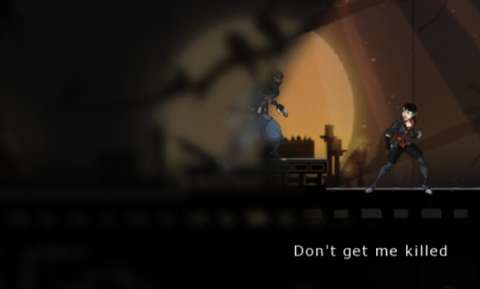
VISUAL DESIGNS:
The most appealing aspect of the game is its visual designs. Although Klei’s colouring and outlining styles would hardly elevate it far above most other game-makers who favor cartoon-like artwork, Klei has some talent that sets it apart.
For one, the sprites in this game have near-seamless blends of spliced-sprite, skeleton-bound animations and fully drawn animation frames. These have been seen before in Shank, but where the animations in Shank were brutish, the ones in Mark of the Ninja display slick finesse.
For example, the animations for successful stealth kills are impressive; enemies are hit with several slashes at vulnerable regions before the killing stroke is inflicted. As another example, there are the animations for the player character’s jumping, running and grapple-zipping. In yet another example, there are the visually distinctive filters for when characters are in the darkness or in the light.
For the most part, the ninja’s sneaking capabilities are portrayed quite well. For example, when he is sneaking around, the care with which he places his feet is noticeable. However, his animations for when he is moving through vents are not exactly convincing; it would be difficult to shimmy through vents through knee and ankle movements alone.
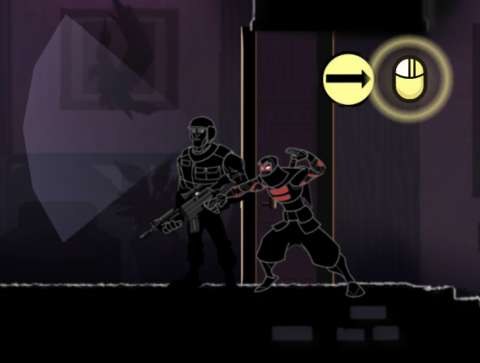
For better or worse, the game recycles models for enemies. There are good reasons for this of course; most of the enemies are uniformly equipped mercenaries, so their visual similarities would have helped the player recognize and determine the capabilities of enemies at a glance.
Yet, there are occasions in the game where the recycling of enemies is not as justifiable. For example, late into the game, the player character suffers hallucinations, which can harm him. Incidentally, these hallucinations take on the form of enemies which the player character has encountered before.
Mark of the Ninja makes use of blurring to render things outside of the ninja’s senses more difficult to see. The most which the player can see in these regions are hazy silhouettes moving about and the waves emanating from footsteps. This effect would be appreciable to stealth-game followers who believe that the player should not have complete awareness of the surroundings.
Unfortunately, there are apparent oversights on Klei’s part on which regions of the screen cannot be seen by the player character. An example is shown in the nearby screenshot.

SOUND DESIGNS:
Klei could have gone on the path of stereotypical Oriental music, e.g. wind and string instruments playing high-pitched tunes. Instead, Klei wisely chose to have a mix of percussion instruments, with taiko being especially prominent.
Most of the occurrences in Mark of the Ninja are accompanied with musical flourishes, such as those for successful stealth kills. Other than that, there are unsettling noises, such as the ones for when the player is navigating menus (which can sometimes be a grating experience because of said noises).
Then, there are the sounds of death and combat. Stabbing noises are of course the most common of these, assuming that the player is skilled enough to make sure that most of what happens in-game are enemies dying from stealthy take-downs. Gunfire has satisfyingly convincing noises too, but the player should not be hearing this often if he/she is competent in the first place.
Perhaps the weakest of Mark of the Ninja’s sound designs are the voice-overs. Some of them, such as those for terrified guards when they are actually saying something instead of screaming and yelping, do not sound particularly convincing in expressing their emotions. (They do sound convincing when they are screaming and yelping, of course.)
The haiku poems and the ninja characters have subdued voice-overs, though one can argue that this should be understandable as they are ninja. Of course, there is the catch that no real ninja has spoken on record, if there is any real ninja in the first place.
BUGS:
Klei is usually very good at quality control; their products are rarely criticized for having glitches which they overlooked. Unfortunately, rare bugs still occur in Mark of the Ninja.
These rare bugs involve the hit-boxes at locations where context-sensitive actions can be performed. An example is described in the nearby screenshot.
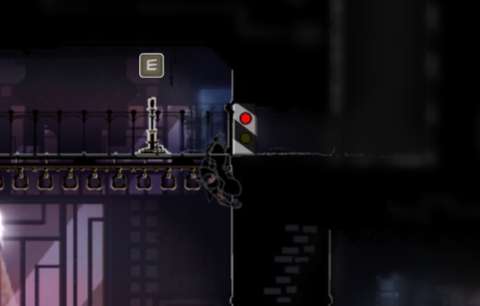
DLC:
Followers of the stealth game genre would notice that Mark of the Ninja has a glaring lack of any means by which the player can take down enemies in non-lethal ways. For better or worse, non-lethal take-downs have been worked into the “Special Edition” DLC instead, together with a few pieces of additional content.
Unfortunately, the Special Edition DLC leads to a more expensive overall tally of costs when purchased as a standalone upgrade, which can sour the opinion of people who bought the license to the vanilla version of the game earlier.
(Fortunately, Mark of the Ninja signifies the end of Klei’s dubious business decisions. After having groped around doing contract work, Klei finally settled to producing independently developed and published games like Don’t Starve and Invisible, Inc., and have focused more on providing value to the customer.)

CONCLUSION:
Mark of the Ninja has minor but many missteps. It has a progression system for the sake of having a progression system when this is narratively inappropriate. There are wasted opportunities for more sophistication in its gameplay. There are also blemishes in its presentation, such as some unconvincing voice-overs. Worst of all, its price-tagged offer on Special Edition content can seem insulting to people who bought the license for the game before the offer was made.
However, if one is to brush such nitpickings aside, Mark of the Ninja is proof that a two-dimensional stealth game can be designed and not seem too dumbed-down due to the lack of a third dimension. There is plenty of slick style to be had, despite the game’s use of the likely overused ninja trope, and more importantly, it copiously rewards caution and planning on the part of the player, which is how a stealth game should be like.
